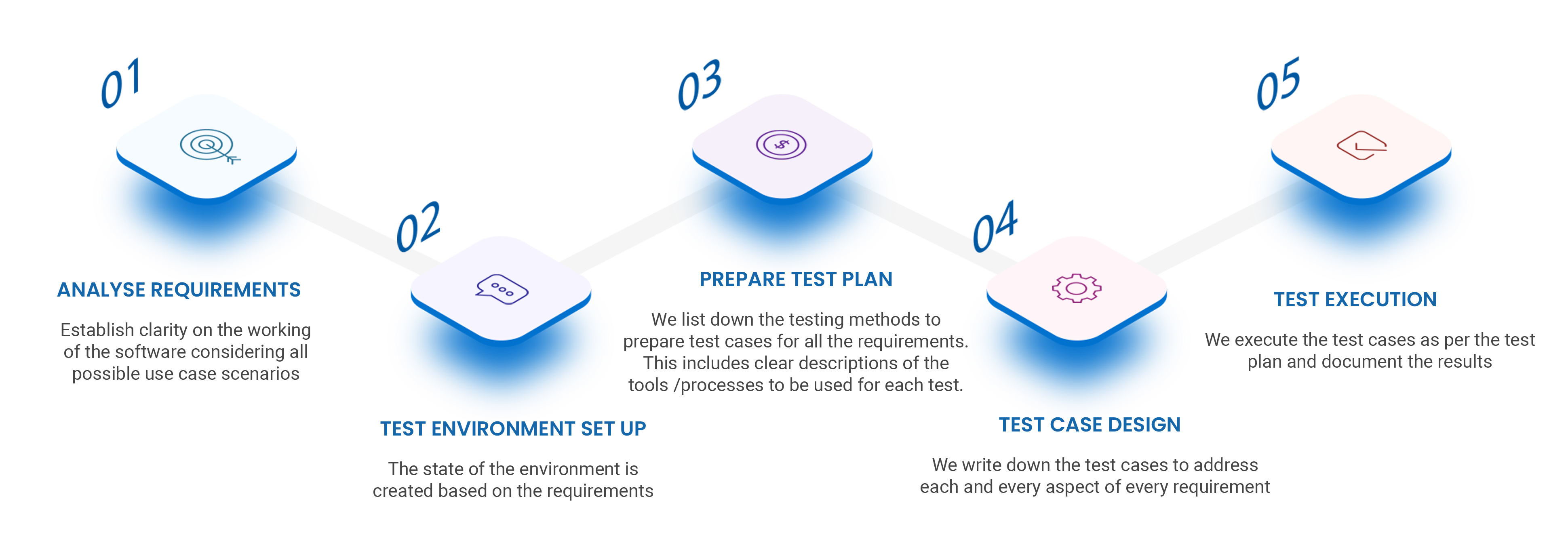We follow the following steps to conduct End-to-End testing.

To create user functions, we do the following:
To create conditions for the respective user functions, we determine a set of conditions for every user function. This includes a list of any factors that can affect user functions.
To build test cases for End-to-End Testing, as a thumb rule, we write multiple test cases for testing every functionality of each user function to address multiple conditions.
To track the progress of End-to-End Testing we take into account the following factors:
Creating the appropriate test cases for each function of the application.
A progress report of the quantum of test completion each week is vital to maintain planned schedules. The parameters considered here are test cases currently in progress, test cases not executed, and failed test cases.
Maintaining a log of identified defects, closed, or opened on a weekly basis is important. We distribute these defects amongst test engineers for resolution based on priority, and that allows test engineers and test managers to keep a track of defects and oversee their resolution.
This gives us a comparison between the time scheduled for testing every day on an as-is-available basis and the time actually spent on testing.
Typically, in most organizations, software applications are rarely standalone. They are connected to multiple systems and databases outside their native environment. Consequently, this makes the workflow associated with the software fairly complex.
End-to-End testing determines whether all the external dependencies of an application are functioning perfectly. It also verifies whether accurate information is being shared across multiple system constituents.
End-to-End testing verifies and validates the database and server-side application layers. This is critical to the proper functioning of the applications since their core functionalities depend on backend infrastructure.
For apps with a complex architecture whose workflows move through multiple layers, End-to-End testing will verify overall functionality as well as the interaction across individual layers in the architecture.
For software based on SOA (service-oriented architecture) or hosted on the cloud, End to-End testing is critical. End-to-End testing verifies the working of multiple components within an application that is required to work in tandem for the successful working of the entire software.
End-to-End testing involves the user interface. This ensures that the application delivers a user experience that works seamlessly across multiple devices, platforms, and environments. End-to-End testing verifies and validates cross-browser compatibility across devices and platforms.
For End-to-End Testing to achieve the best results, we follow the below-mentioned practices to ensure a smooth testing process while keeping the costs in check.
While creating test cases, we keep the user in mind. Our test engineers get into the mindset of a user using the software for the first time. Are you able to easily find your way around? Are the features easily navigable? Can users get what they want within two or three clicks? We make use of acceptance testing documents and user stories to clearly establish the user’s point of view and subsequently design the test cases accordingly.
We focus our End-to-End Testing efforts on features of the software whose failure can potentially create maximum problems. We start with such features first, and design comprehensive test cases to verify them. It’s like creating a risk assessment matrix for the software.
End-to-End Testing is best suited to test common use cases. For testing exceptional user scenarios, integration testing, or low-level unit testing is better suited.
Since End-to-End Testing covers the entire software, test cases are going to be complex. Each and every component of the system needs to be tested, which adds to the probability of failure as well as the complexity of debugging each anomaly. How we structure and organize the End-to-End testing process is very important. Our test engineers conduct unit and integration tests to begin with to resolve the first level of bugs.
Given the nature of End-to-End Testing, and the fact that it verifies and validates the entire system, literally from end to end, it needs detailed planning from the very beginning of a project. End to End testing is best managed manually, as it allows testers to put themselves in the users’ shoes. Having said that, in certain scenarios, automation testing may be a good option. In those cases, we limit it to features that are low-risk and require repetitive action.
We view End-to-End testing as a must-have part of the testing journey. Prepare early, and allocate time, effort, and resources to it for delivering a seamless user experience and prevent disruptions in their experience.
Throughout the testing lifecycle, we conduct all necessary types of testing: performance, functional, security, usability, database, API, Integration, and more to offer maximum test coverage.
You will get complete transparency of our testing activities and we take full responsibility for them. Also, our testing teams are experts in fully aligning our testing methods with your business processes to maximize the efficiency and efficacy of our testing.
Before we start testing, we establish the most critical quality assurance KPIs of your business and keep you updated about their status. This allows you to track our progress on the testing activities and verify if the intermediate results are in sync with your business goals.